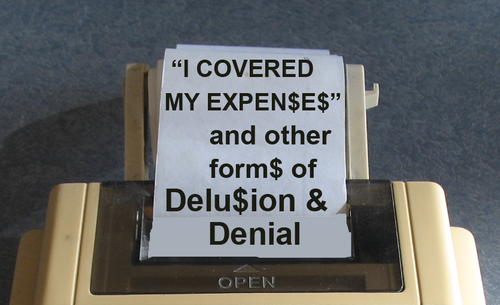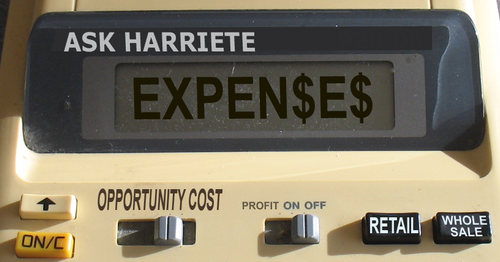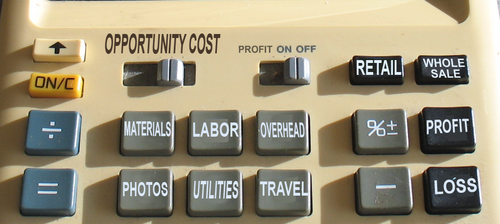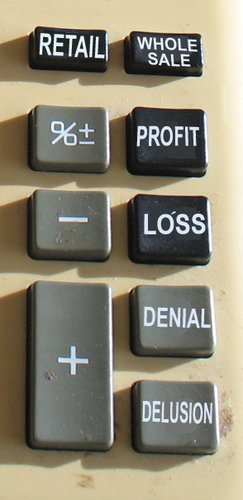by guest blogger Harriete Estel Berman

A true story . . .
“Looking back, my booth was pretty bad, I think I did all the display mistakes you list. I was so crazed trying to have enough work that I didn’t have my act together when it came to the booth. It was a cluster ‘you know what’ all the way around. The show was so much work . . . but in the end I broke even.”
This story tells a familiar tale — and one moral of the story is that we all make mistakes and we can learn from our experience. There is no problem, if we learn.
But that last phrase is one that I hear over and over, “In the end I broke even.” Too often this perception of “breaking even” is a misperception — actually a trap — that too many of us fall into.
Let’s start with what people really mean when they say “I broke even.” Typically what they mean is that they took in enough gross revenue to equal their show fees and travel expenses only.
Unfortunately such statements may be comforting to the ego — while costing them a lot of money.
The delusion of “I covered my expenses” relies on the denial of the true total costs and expenses of participation in a show.

What are typical show expenses?
A quick list includes:
- application fee
- photography
- booth fee
- travel expenses including driving or a flight, food and lodging
- booth tent purchase or rental
- display tables/cases
- drape/fabric for display
- lighting
- signage
This is a quick list. But these are only the “out of pocket” expenses — the show expenses for which you can obtain a receipt and itemize on your income tax forms.
What is not itemized is YOUR TIME:
- one/two days packing
- two days at a show
- one/two days unpacking and recovering
- and time traveling to and from the show
Should you include the two days of packing? Of course.
How about the two days at the show? Absolutely!
What about the time for unpacking / managing inventory while you recover at home?
It is quite common to invest several days before and after a show not even counting travel time.
You expect to make money for your time don’t you? An example of the arithmetic:
(6 days) x (8 hours per day) x ($15 per hour) = $720 unaccounted
What is your time worth? $25/hour? $10/hour? $0/hour?

In business, each day you invest in one activity could be considered as your “opportunity cost.” What could you have been doing otherwise with the days consumed by participating in the show? Would you have completed a piece or two or more? Would you have arranged for a gallery show or done website marketing? What would you have created if you weren’t making the production “sell-able” bread and butter items that you need to sell to cover your expenses at the show?
The point is that spending several days of your time preparing for, attending, and recovering from a show is an opportunity cost (at a minimum) that you could have used to complete other tasks, experiment with new work themes, or earn income from other sources (opportunities).
Retail Sales? or Net Income? . . . more delusion & denial
Another “faulty accounting” misconception in the delusion and denial realm is that the gross cash inflow (the total amount of revenue generated at the show) is all profit. This isn’t true. A show is really a marketing or retailing activity. Retailing expenses are typically accounted as only half of the retail price. The other half is the wholesale price which covers the manufacturing/ fabrication/shop overhead plus (hopefully) a small percentage for profit. The wholesale price is where the artist/maker covers the cost of materials, tools, equipment, overhead (studio utilities, maintenance, insurance, taxes, health insurance, etc.) and an hourly wage for fabrication.
Similar to a gallery relationship, your show participation is like a “pop-up” gallery and you are playing the role of a temporary gallery operator marketing the work of an artist with whom you split the retail sales 50/50. Consequently only half of the cash inflow from a show should be allocated to “covering your retail expenses.”

Bottom Line
The “delusion and denial” lesson here is to be really honest about your retail experience. Delusions and denials do not make money.
A show is a marketing opportunity and your decision to participate should factor in all the costs including your time expended, production expenses and a realistic wage for your time. With full awareness of all the costs of participating in a show — choose wisely.
 Harriete Estel Berman received her BFA from Syracuse University in 1974 and a MFA from Tyler School of Art, Temple University in 1980. Since then she has exhibited regularly in the United States and Europe including seven one person shows. In addition to teaching, giving workshops and lectures, her work is in the permanent collections of 15 museums and featured in over 38 books. Berman is the author of the Professional Guidelines and offers professional development advice and information to the arts and crafts community.
Harriete Estel Berman received her BFA from Syracuse University in 1974 and a MFA from Tyler School of Art, Temple University in 1980. Since then she has exhibited regularly in the United States and Europe including seven one person shows. In addition to teaching, giving workshops and lectures, her work is in the permanent collections of 15 museums and featured in over 38 books. Berman is the author of the Professional Guidelines and offers professional development advice and information to the arts and crafts community.
Photo credit: all photos by Harriete Estel Berman


I think its time to be very honest with ourselves, the other sellers and the show organizers. If this business model isn’t working why do we keep repeating the same mistake?
There are lots of ways the current arts/crafts shows model could be changed, but to continue with a 1980’s model without the revenue stream is a poor practice from top to bottom.
Show organizers are also saying “I covered my expenses” and everyone puts on a pretense they are making an appropriate amount of money for the time invested.
It’s time you calculated your expenses along with reality.
I’m still “recovering”from a gallery show in Florida over a year ago. It involved packing paintings and driving for 2 days to get there for the opening reception. The reception was well attended, but the sales didn’t happen. I also had to drive back to pick up the paintings a month later.
I was so excited to show in a new market and the gallery featured my paintings in a glossy magazine, that was enough to entice me to do it. But, I didn’t consider all that would be involved.
I have to learn from experience and I did from that one.
Very interesting story, Lynn. Although I’m sure the gallery intended to sell your paintings, you are left considering whether the cost of getting exposure was worth it. If given a similar opportunity in the future, what would you tell them?
Great post, Harriete! I couldn’t agree more!
I just participated in a show that in the past had been profitable, but hit bottom this year. I observed that none of the artists were selling much, and that the customer base had shifted from buyers to lookers, as if they were at a museum and not a store.
After the show, I calculated my gross income minus costs, including the hours I’d spent pre- and post- show, and determined I’d made about $1/hr. Needless to say, I won’t be returning.
We need to ask ourselves in situations like this, “Could I hire someone to do all of this (pre-show, show, and post-show) for $1 an hour? Or worse, not pay them at all?” We have to realize that this is exactly what we are asking of ourselves! We need to be business-minded people and to calculate our true costs versus benefits of “opportunities.”
That being said, there ARE some events that are great marketing opportunities. We know going in that we may not make many sales at the event, but instead are laying the groundwork for bigger and better income potential with the exposure and connections within the client base. In those cases, the calculated expense is a part of our marketing budget.
I like seeing articles like this one. This is how we help each other become more successful artists! Thank you, Harriete Estel Berman and Carolyn Edlund!
Interesting comment, Julie. I agree that there are times when you go in knowing that the event may not produce immediate sales or results, but might be a good place to network, meet the right people or get some exposure.
The task then becomes following up with everyone and making sure that you stay in touch. That can be one of the biggest challenges for artists (and for everyone else too). In that case, I think advance planning with a big picture view is a great idea.
THANK YOU, thank you, thank you, Harriete Estel Berman!!! This is such a reality check and I really needed one right now. – Off to regenerate my energy.
We quit selling porcelain jewelry pendants and beads after 7 years of watching the promoters make money 350 booths @1900 a booth X 10 shows.. go figure.
It was an ego delusional trip; lots of fun but not fiscally sound. I miss the nomad artists but not the experience. Joan t
I all too often have had this experience. I think it is a necessary one though, IF, as mentioned you learn. I have done some shows like this that neither bought many sales or clients. I now research the shows more thoroughly, and am more discerning about which shows I want to participate.
I stopped doing anything for “exposure” several years ago along with many outdoor shows. You are absolutely correct that many do not take into account thier own pay for organizing everything, transporting art to a show and working the show. Show organizers (not all of them) tell themselves they wish to give opportunity for artists to display thier work and get sales, when in reality, no one profits from this. From an artists perspective, you are providing the attraction. It is the onus of the organizer to plan, advertise and market the event to profit all. I think the best is when the sales go through one process and the organizer takes a percentage of the sales vs booth rents. This makes the organizer choose artists carefully and advertise properly because the hit they take will be thier own vs the Artist walking away because they had to speculate whether this show would be a good one for them.